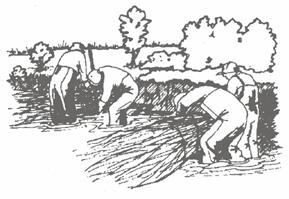|
9.3.
Stream Enhancement Methods
Some enhancement can be very simple:
- Removing debris and garbage that has blocked a watercourse
obstructing access to spawning and nursery areas.
- Cleaning up garbage and minor pollution sources. Later in
this section there are tips and rules for performing clean-ups
on watercourses. |
- Planting
trees and shrubs. Planting helps stabilize banks, increases
the amount of leaf fall into the stream, and provides cover
for fish. In some cases volunteers can strap bundles of willow
or other vegetation to help eroding banks.
- Placing fencing along the watercourse to keep grazing animals
out of the water and from over grazing grasses and shrubs along
the water's edge.
- Repairing culverts so they do not obstruct migrating fish.
|
 |
Other enhancement activities
may be more complex such as restoring the stream channel, putting
in stream enhancement devices, fishways, or fish screens.
- Restoring the stream channel includes using a combination
of stream enhancement techniques to work with or help the natural
flows. Structures are designed and put into the stream to help
clear sand and silt out of the bottom and develop a narrower,
deeper channel with well-formed pools and riffle areas. Stream
flows can be very powerful and do extensive damage if not properly
used. The design of instream restoration work must be done by
trained professionals but be sure to accompany them when they
lay out the work so you can understand what has to be done.
If the work is not designed properly all of your work might
be fruitless. For example, if the device is not placed in the
correct place it might be washed out in the spring. Once the
needs of your stream are established and a pattern developed,
your group can often continue to layout the work to the next
major tributary. |
|





|
|
|
|
![]()
